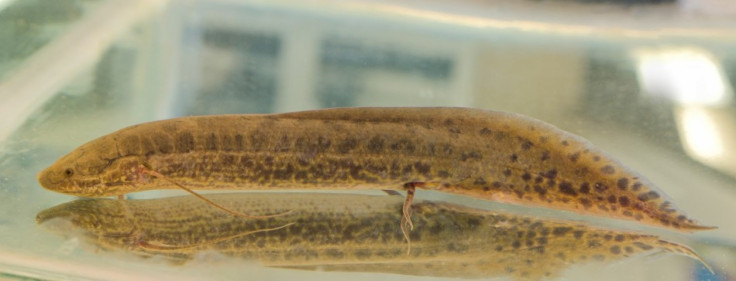Fish Walked in Water Before Land: Study Concludes

Four-limbed sea creatures from which humans descended walked in water before they walked on land or even developed fingers and toes, new research suggests.
Scientists at the University of Chicago observed lungfish - freshwater fish closely related to the original four-limbed tetrapods - and noticed that the fish use their stringy back limbs to propel themselves along stream beds.
Since lungfish don't have fingers or toes, the observation also suggested that tetrapods exhibited walking behavior before they developed digits, shedding light on the order of the evolutionary process by which water creatures made the transition to becoming land inhabitants during the Devonian period approximately 400 million years ago.
The journal the Proceedings of the National Academy of Sciences published the study online Monday.
Previously, little research focused on the movement of lungfish along stream beds - ie the bottoms of rivers and other fresh water bodies -- save for some observational studies of lungfish in the wild from the 1950s.
There wasn't a lot of detail there, lead author Heather King told International Business Times. I wanted to expand on that.
So King filmed eight lungfish individually in a tank of still water with a plastic mesh at the bottom for traction. King filmed the fish from bottom and side angles. The side angle was what really helped to see the walking behavior, as it showed the lungfish using their back limbs along the bottom of the tank to push themselves forward. We didn't know what they would be doing, King said.
King and her fellow researchers saw that not only were the lungfish using their short, stringy back limbs to propel themselves along the bottom of the tank, they were also using those limbs to lift themselves off of the floor.
The researchers theorize that since lungfish have lungs, the air in the lungs provides the fish with more buoyancy, which allows them to use just their back limbs to push themselves forward.
That would make a lot of sense and that also makes it more relevant for these animals in the Devonian, King said.
The next step for King, who is finishing her doctoral thesis, would be to understand the anatomy of those limbs. It doesn't look like a walking limb, she said.
The study shows how certain traits can evolve to serve more than one function, a trend called exaptation by evolutionary biologists, according to Rui Diogo, assistant professor at Howard University and a resource faculty member at George Washington University who was not involved in the study.
Tthe typical gaits (associated with the locomotion) of tetrapods were probably not selected for their current purpose, which is mainly walking in land, but instead for moving the fish inside the water, Diogo wrote IBTimes in an email. This is another powerful example of exaptation. By showing this, the paper helps to better understand one of the most dramatic evolutionary transitions in biology: the origin of tetrapods, and the transformation from fins to limbs.
READ ALSO: Pet Burial: Owners Can Rest in Peace With Beloved Critters
© Copyright IBTimes 2024. All rights reserved.





















